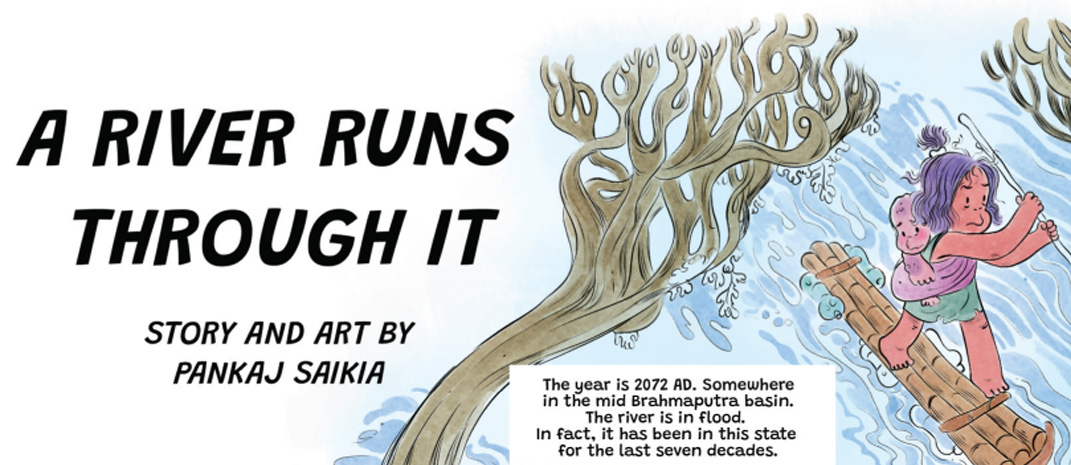
Vol 2 No 4 | Jan-Mar 2023
A River Runs Through It
Story and art by Pankaj Saikia
The story is inspired from a folktale of the Mising tribe about a woman who transforms into Sishu, the river dolphin found in the Brahmaputra river valley. The indigenous tribes of the region, like the Mising, have historically resided near the banks of the river, their livelihoods deeply connected with its ebb and flow. Changes brought about in these patterns due to big dams and other ‘development’ projects have serious repercussions on their lives, an outcome usually ignored in taking decisions about such projects.
https://www.sapiens.org/culture/mising-river-people-assam-india/
Ganges River Dolphins
The Ganges river dolphin (Platanista gangetica) is a species of toothed whale. It can be found in rivers such as the Ganges and the Brahmaputra in India. Despite being designated the National Aquatic Animal of India, it’s an endangered species, its existence threatened by illegal fishing and changes in the river water flow due to dam construction. It uses echolocation for hunting, which is also often disrupted by the sound caused by motorboats and large ferries on the river. In Assamese, it is commonly known as Sishu/Xishu.
https://www.worldwildlife.org/species/ganges-river-dolphin
The Brahmaputra River
The Brahmaputra River has a mean annual discharge of about 20,000 m3/s. The Ganga–Brahmaputra–Meghna river system that it is a part of is the third largest river system in the world (tied with the Río Orinoco, Venezuela) in terms of annual discharge after the Amazon and Congo.
The river rises from a highly-glaciated upper basin encompassing the Eastern Himalaya and parts of the Southern Tibetan Plateau (where it is known as the Yarlung Tsangpo). It then sweeps eastward through southern China before entering Indian borders in Arunachal Pradesh and traversing much of Assam where it broadens into a vast width in the plains. Exiting Assam, it flows on into Bangladesh, where it is known as the Jamuna. The river’s high volume of flow is caused by snowmelt in its upper reaches, augmented by heavy annual precipitation in much of the area that it flows through.
The river and its tributaries provide important societal, ecological, cultural, and economic services to more than 60 million people in Bangladesh, north-eastern India, Bhutan, and Tibet, China. These benefits include fish (a primary source of protein in the region), water for irrigation, the deposition of fresh sediment to sustain the large inhabited riverine islands (known as chars), and the prevention of salt-water intrusion from the Bay of Bengal into the low-lying Sundarbans delta.
https://www.britannica.com/place/Brahmaputra-River
The flooding of the Brahmaputra
The annual flooding of the Brahmaputra is an accepted part of life in Assam and Bangladesh. This makes it a frequent cause of human suffering in those regions, with the most widespread disruptions occurring during the monsoon season between July and September. For example, the year 1998 witnessed intense monsoon flooding between July and September in both Bangladesh and Assam, inundating nearly 70% of Bangladesh, affecting over 30 million people and causing a humanitarian emergency in the region. Such calamities have become more frequent, and poor disaster management response has caused large numbers of fatalities, permanent loss of livelihoods, and the displacement of thousands of people, in addition to raising regional food security concerns due to famine from damaged crops. Intensification of the monsoon linked to climate change, along with the accelerated warming-driven glacial melt, is likely to increase the scale of such flooding in future.
https://www.thethirdpole.net/climate/stilt-houses-assam-help-people-withstand-floods/

